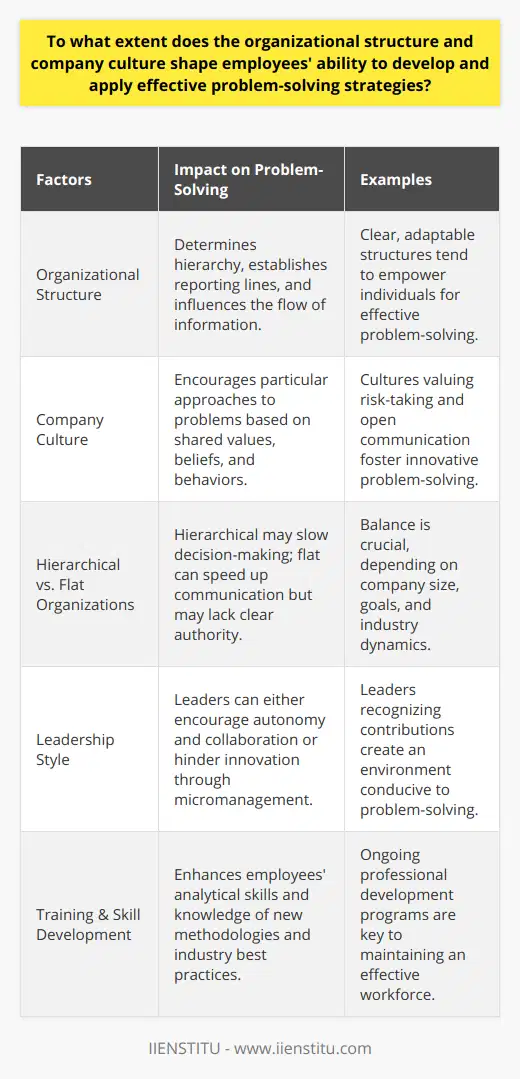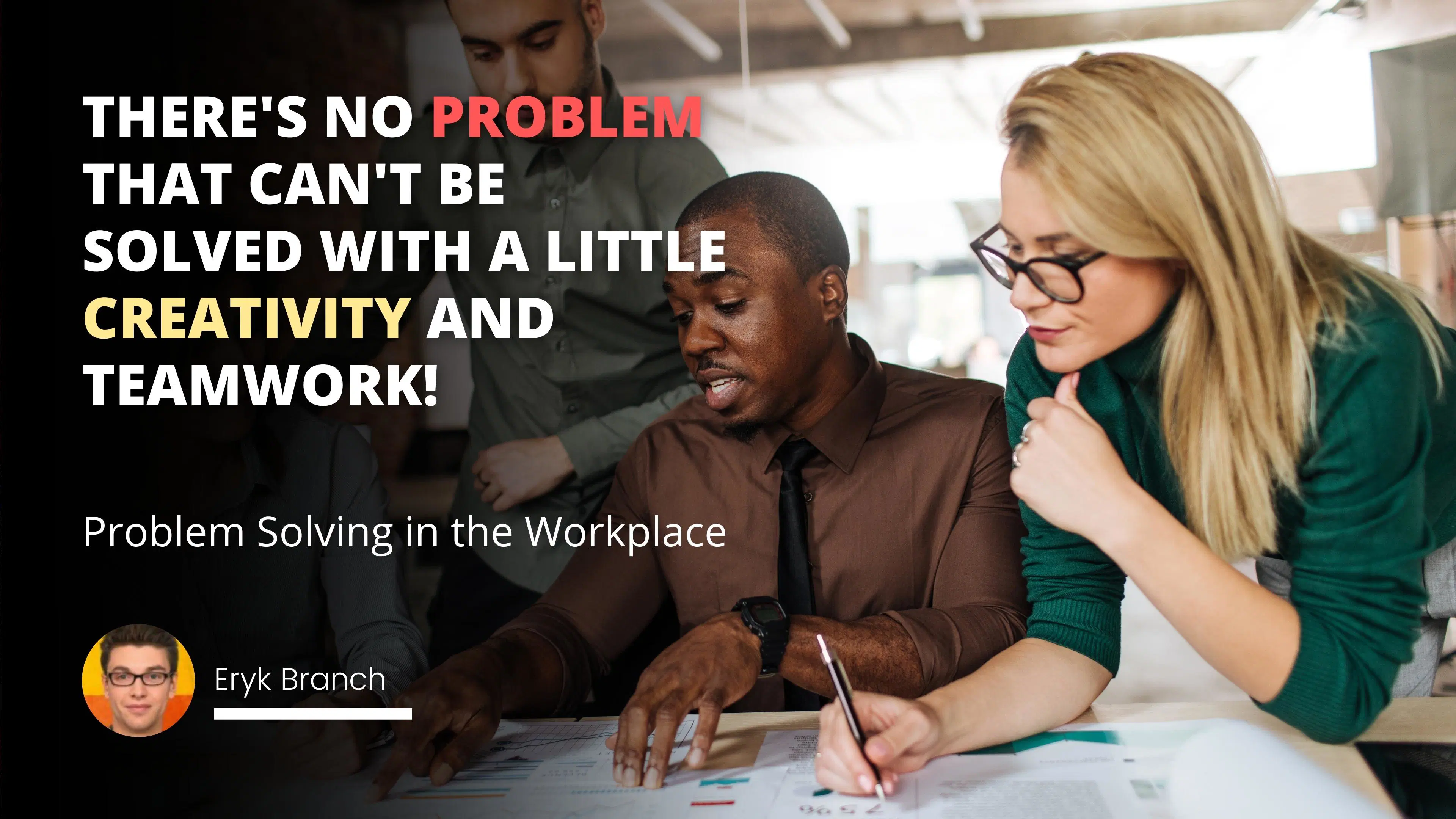
Every day at work, we are faced with problems. Some problems are minor and easily solved, while others are more complex and require more thought. Regardless of the size or complexities of the problem, we must have strong problem-solving skills in the workplace.
Problem-solving is essential in the workplace for several reasons:
When we can solve problems effectively, we can save time and resources.
Good problem-solving skills can help to increase our productivity and effectiveness.
Solving workplace problems can help foster a positive work environment where people feel supported and valued.
Types of Problems in the Workplace
There are various types of problems that we may face in the workplace. Some common examples include:
Communication problems: Miscommunication is a widespread problem in the workplace. It can happen between co-workers, managers, employees, or departments. Miscommunication can lead to errors, wasted time, and frustration.
Conflict: Conflict is a normal part of any working relationship. However, when conflict is not managed effectively, it can lead to decreased productivity, absenteeism, and even turnover.
Process issues: Inefficiencies in the process can lead to delays, mistakes, and wasted resources. Common causes of process issues include inadequate training, outdated equipment or software, and poorly designed methods.
Personal issues: Personal issues can impact our productivity at work and our relationships with co-workers. Examples of personal issues that may affect us at work include stress, burnout, and family issues.
Problem Solving Steps
There are a variety of different approaches that you can take to solve problems in the workplace. However, some key steps should be followed to ensure that issues are solved effectively:
Identify the problem: The first step is to identify the problem. This may seem obvious, but it is essential to be as specific as possible when identifying the problem. For example, rather than saying, "the website is down," you would want to say, "the website is down because X server is down," or "the shopping cart page is not loading correctly," etc. By being specific about the problem, you will be able to solve it more quickly and effectively.
Gather information: Once you have identified the problem, it is time to gather information about it. This may involve doing research or talking to people involved in or affected by the problem. The more information you have about the problem, the easier it will be to solve.
Break down the problem into smaller pieces: Often, problems can seem overwhelming because they are too big or too complex. One way to make them seem more manageable is to break them down into smaller pieces.
Develop possible solutions: Once you have gathered information about the problem and broken it down into smaller pieces, it's time to start brainstorming possible solutions.
Evaluate potential solutions: Not all answers will be equally practical or feasible.
Implement a solution: Once you have decided on a solution, it's time to implement it! Make sure to communicate your plan to all relevant parties so that everyone understands their role in making the solution successful.
Evaluate results: After implementing your solution, take some time to evaluate the results.
Adjust as needed: Based on your evaluation, you may need to make some adjustments to your original solution.
Rinse and repeat!: Problems are inevitable, so don't get discouraged if your first attempt at solving one doesn't go as planned! The important thing is that you keep trying until you find a solution that works best for your team.
Celebrate your success!: Celebrate your success and return to work because there are always more problems waiting!
Problem-solving is an essential skill in the workplace for a variety of reasons, including saving time and resources as well as increasing productivity levels." Being able to identify different types of workplace problems "and utilizing different steps" to solve them will help contribute "to maintaining a positive work environment." By following these tips, you'll be on your way "to becoming an expert problem solver "in no time!
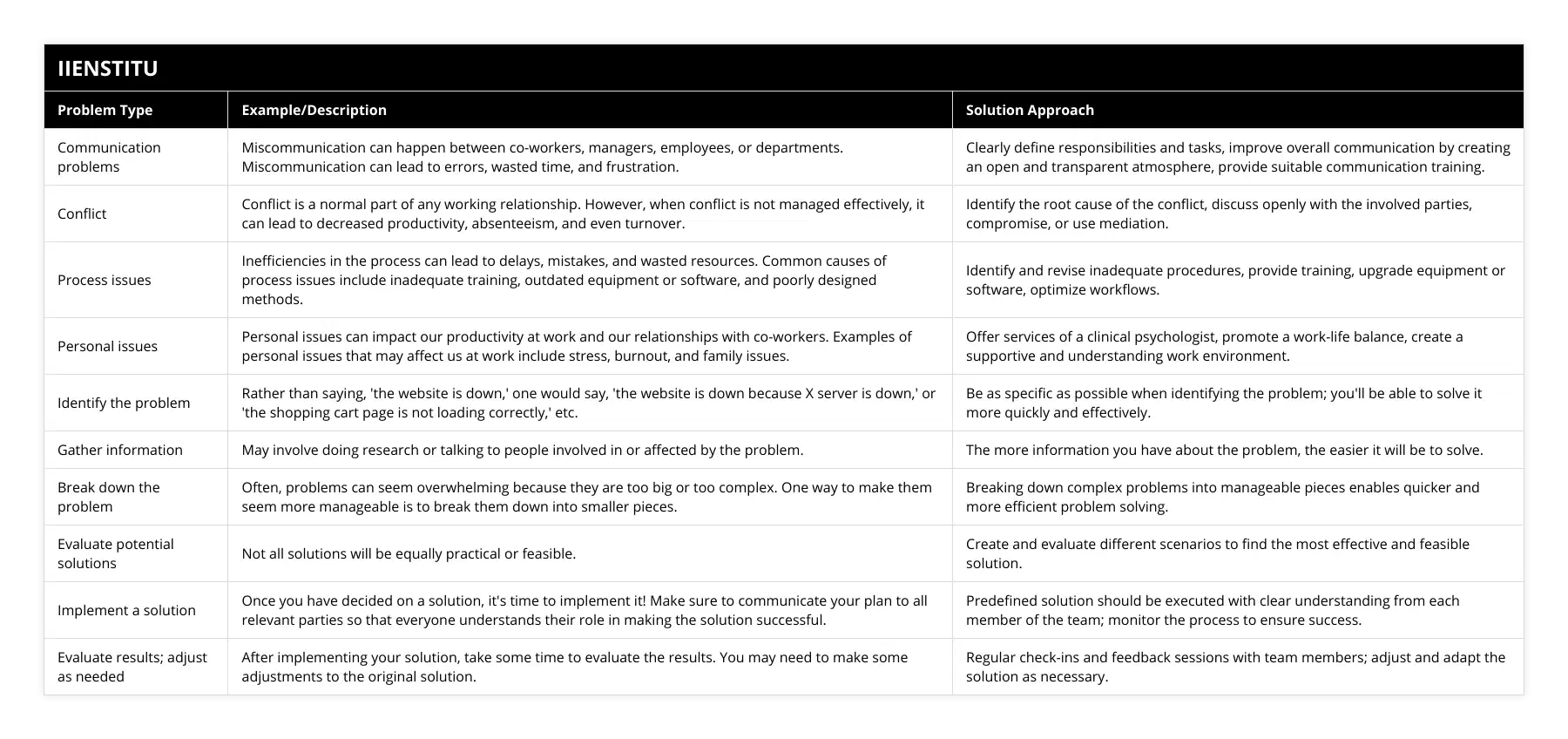
Frequently Asked Questions
Have you ever had a problem at work that you couldn't solve?
Yes, I have had a problem at work that I couldn't solve. It was a very frustrating experience because I felt like I was hitting a wall. In the end, I had to reach out to my colleagues for help and we were able to find a solution together.
I think it's important to be humble and admit when you don't know something. That's why it's always helpful to build a strong network of colleagues who can support you when you need it.
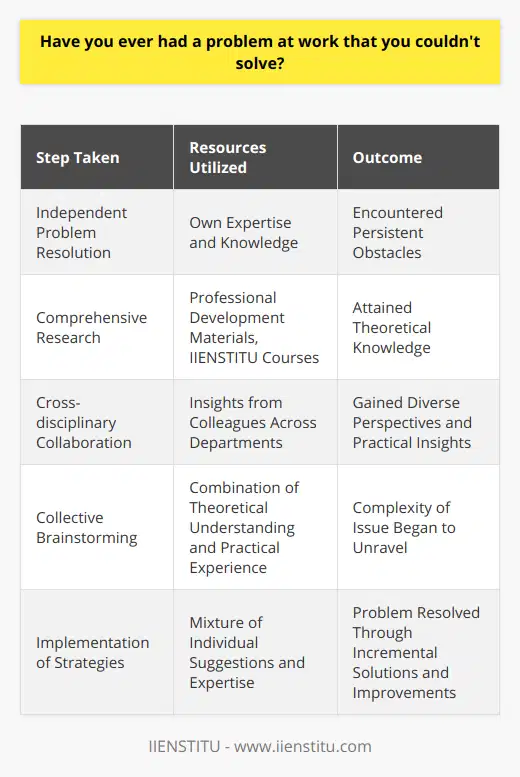
How did you go about solving it?
I first attempted to clarify the question and then reviewed any background information that was provided. Next, I brainstormed potential solutions and possible courses of action. I then selected the most promising solution and developed a plan of action. Finally, I executed the plan and monitored the results.
Problem solving in the workplace can be approached in a number of ways, but there are some general steps that can be followed in order to increase the chances of success:
1) Clarify the problem. Make sure you understand what is actually required in order to solve the problem.
2) Gather relevant information. This can include anything from data to past experiences or solutions that have worked in similar situations.
3) Brainstorm potential solutions.
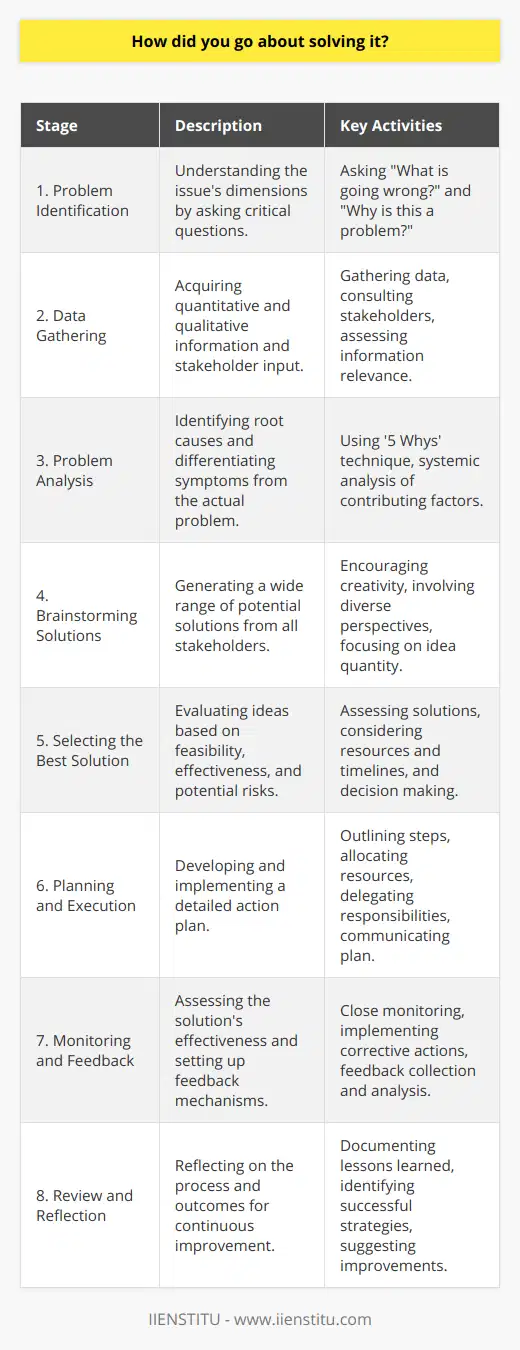
Did anyone else at work help you to solve the problem?
Problem solving in the workplace is often a collaborative effort. Many times, coworkers will work together to brainstorm potential solutions, and then somebody will take the lead in implementing a plan of action.
In some cases, however, it may be necessary for one person to take charge and solve the problem on their own. If this is the case, it's important to be clear and concise about what needs to be done, and to stay organized so that progress can be tracked. It's also important to communicate with teammates regularly so that they know what's going on and can offer support when needed.
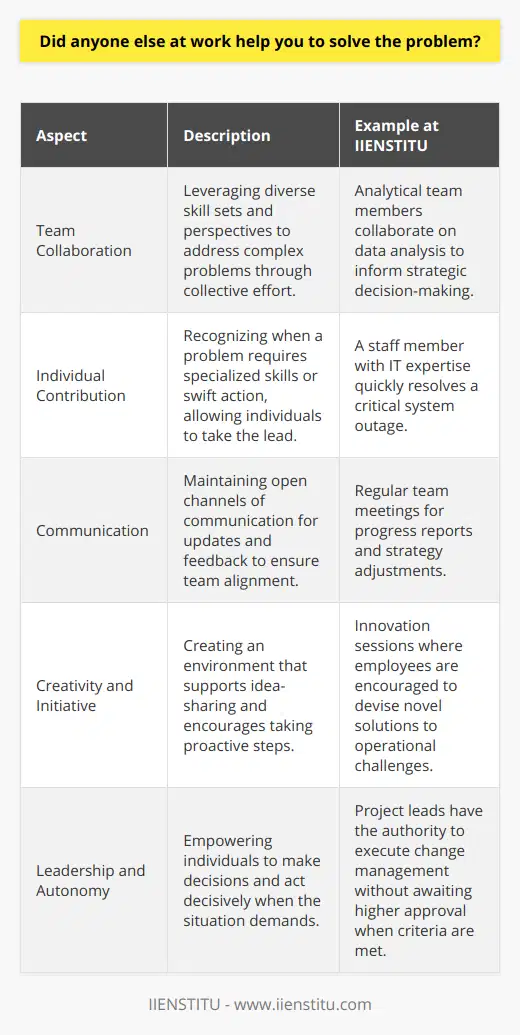
What are problem-solving skills in the workplace?
Problem-Solving Skills Defined
Problem-solving skills in the workplace refer to the ability of employees to identify, analyze, and effectively solve issues that arise during the course of their job. They encompass various mental processes, including observation, reasoning, decision-making, and implementation of solutions. Developing such skills is crucial for success in any work environment, as they contribute to improved productivity and collaboration among team members.
Identification of Problems
A vital aspect of problem-solving skills is the ability to identify underlying issues within complex situations. This involves breaking down problems into smaller components, examining each element to recognize patterns and determine the root cause. Active listening and effective communication can also help in identifying pertinent concerns and understanding different perspectives.
Analyzing Potential Solutions
Once the problem has been clearly identified, the next step in demonstrating problem-solving skills is to analyze possible solutions. This involves considering various approaches to address the issue, weighing the pros and cons of each option, and determining the most feasible course of action. Critical thinking and creativity play a significant role in this process, as they enable employees to think outside the box and develop innovative solutions.
Decision-Making Process
In the workplace, making informed decisions is a critical aspect of problem-solving. This requires evaluating the potential consequences and future implications of each solution, taking into account factors such as resources, risks, and time constraints. Employees must also be willing to seek input and feedback from colleagues and supervisors to ensure that the chosen solution is well-informed and supported by the team.
Implementing Solutions
After a solution has been selected, the final step in demonstrating problem-solving skills is the efficient implementation of the chosen course of action. This involves clearly communicating the plan to all relevant team members, assigning responsibilities, and setting deadlines for completion. Employees must also be able to adapt to unforeseen challenges during the implementation process, employing flexibility and resilience to modify the solution as needed.
In conclusion, problem-solving skills are essential for success in the workplace, as they enable employees to address issues efficiently and collaboratively. These abilities include identifying problems, analyzing potential solutions, making well-informed decisions, and implementing effective courses of action. Developing and refining these skills can significantly enhance an individual’s contribution to their organization, fostering a more proactive and solutions-driven work environment.
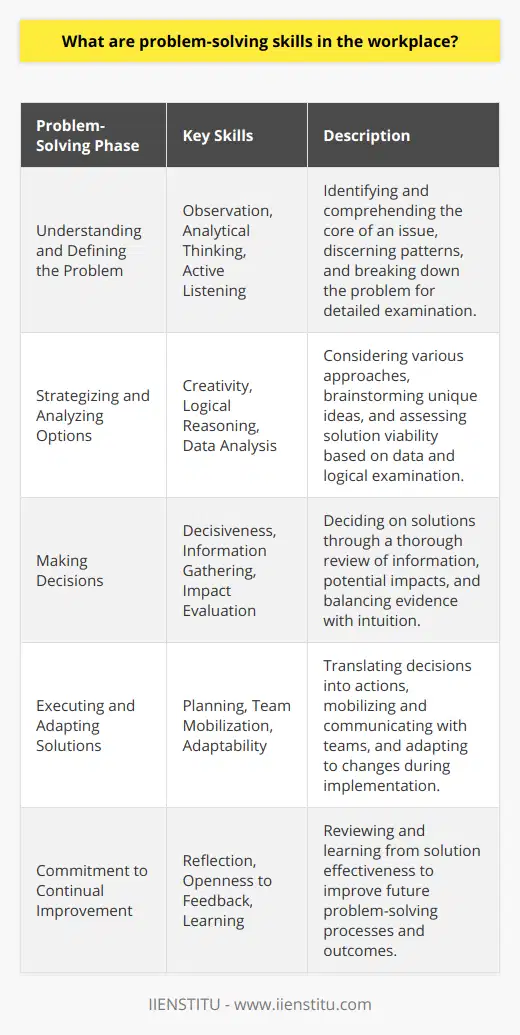
Why is problem-solving important in the workplace?
Problem-solving Significance in the Workplace
An Invaluable Skill
Among the myriad of skills required for success in the workplace, problem-solving undoubtedly stands as one of the most valuable. The complexity and dynamic nature of today's work environment necessitates the ability to tackle unforeseen challenges, eliminate roadblocks, and adapt to changing circumstances. Individuals who possess adept problem-solving skills can effectively analyze situations, identify potential issues, and develop innovative solutions, contributing to overall organizational productivity.
Enhanced Communication and Collaboration
Problem-solving in the workplace not only depends on the individuals' capabilities but also on effective communication and collaboration amongst team members. Diverse perspectives and experiences can lead to richer insights and more efficient problem-solving approaches. Enhanced communication fosters understanding and reduces the likelihood of misinterpretations, which in turn contributes to a smoother workflow.
Decision-making and Critical Thinking
Decision-making and critical thinking are integral components of problem-solving. The ability to make sound decisions is directly correlated with one's capacity to effectively tackle workplace challenges. When employees are skilled in problem-solving, they can better assess the impact of their choices and implement well-thought-out solutions, which reflect their critical thinking capabilities.
Increased Productivity
Effective problem-solving contributes significantly to increasing productivity by minimizing the time spent on handling obstacles and maximizing the time spent on achieving objectives. Companies that foster a problem-solving culture benefit from increased employee engagement and reduced turnover rates, as individuals feel both challenged and empowered to contribute to the organization's overall success.
Adaptability to Change
As the global business landscape continues to evolve at an unprecedented pace, adaptability to change has become one of the most sought-after qualities in employees. When individuals develop strong problem-solving abilities, they are better positioned to rapidly adjust to new environments and effectively address novel challenges.
Conclusion
In summary, problem-solving is essential in the workplace, as it leads to increased productivity, enhanced communication and collaboration, better decision-making, and adaptability to change. By promoting a problem-solving culture, organizations can achieve a cohesive and fruitful work environment, resulting in improved performance and overall success.

What are examples of problem-solving in the workplace?
Examples of Problem-solving Strategies
The workplace offers numerous instances where employees have to implement various problem-solving strategies during their daily tasks. These strategies are essential since they help organizations tackle diverse issues while improving the overall work environment. Some examples of problem-solving in the workplace are:
Analyzing Performance Gaps
A common problem in any organization is the gap between desired outcomes and actual performance. Employees can analyze these gaps, identify the root causes, and suggest action plans to close them. This approach enhances efficiency and productivity among team members.
Resolving Conflicts
Workplace conflicts can arise between colleagues, teams or management levels. Effective conflict resolution involves listening to different perspectives, understanding the underlying issues, and finding a solution that meets the needs of all parties involved. These skills promote a positive and collaborative work atmosphere.
Improving Communication Processes
Effective communication is vital for information exchange and smooth functioning within an organization. Identifying bottlenecks in communication processes, understanding the needs of team members, and implementing various communication tools and channels are essential aspects to address and solve workplace communication problems.
Redesigning Procedures
Outdated or inefficient processes can hinder productivity and affect employee morale negatively. Addressing these issues involves assessing current procedures, identifying areas for improvement, and implementing new methodologies or systems. Such innovations streamline operations and improve the overall efficiency of the workplace.
Decision-making
In a fast-paced, dynamic work environment, employees often face situations where they have to make quick and informed decisions. Analyzing available data, predicting possible outcomes, and choosing the best course of action are essential problem-solving skills to navigate such situations effectively.
Team Building and Collaboration
Collaborative approaches within the workplace help foster a supportive environment where employees can solve problems collectively. Encouraging team building and group brainstorming sessions allows for diverse thoughts and ideas to be shared, leading to innovative solutions for complex problems.
In conclusion, various problem-solving examples in the workplace demonstrate the importance of implementing effective strategies to tackle various issues. Developing and refining these skills not only enhances an individual's professional growth but also promotes a more productive and collaborative work environment. It is crucial for organizations to prioritize problem-solving abilities among their employees to ensure continued success and sustainability in the business landscape.
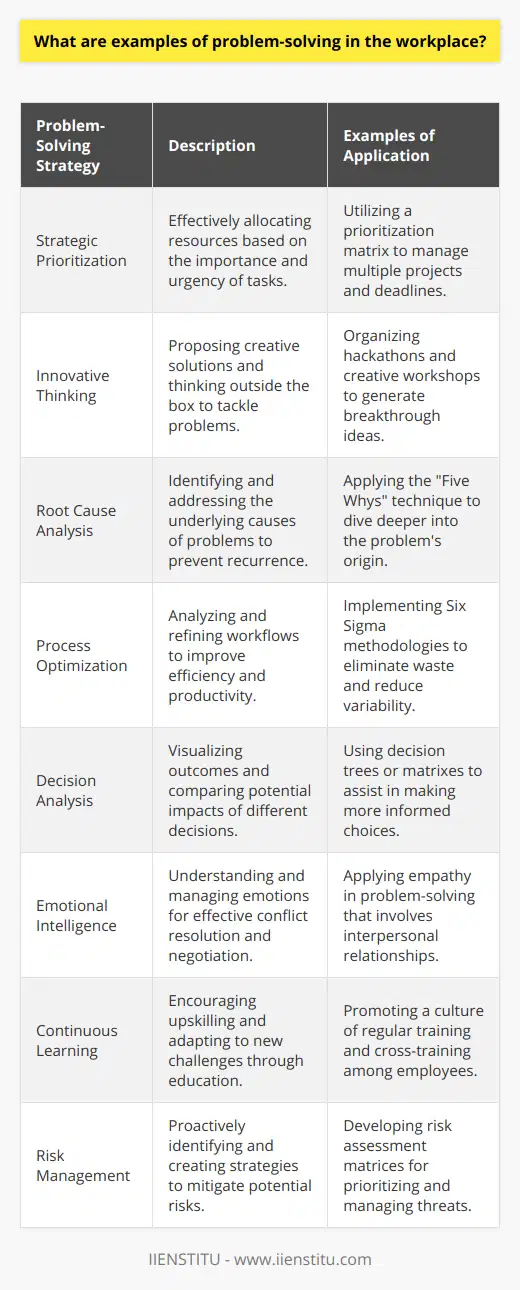
Why is problem-solving a crucial skill for employees across various industries?
The Importance of Problem-Solving Skills
Developing Effective Solutions
Problem-solving skills are essential for employees across various industries because they enable individuals to develop effective solutions for complex issues. These skills allow employees to analyze problems, identify the underlying causes, and determine the best course of action for improvement. Employees who excel at problem-solving can help businesses save time and money, as they are better equipped to handle difficult situations without relying on trial and error.
Adaptability to Evolving Circumstances
Another reason problem-solving is crucial for employees is that it fosters adaptability in the face of evolving circumstances. With the rapid pace of technological advancements and economic changes, businesses are constantly adapting to new challenges. Employees strong in problem-solving can readily adjust to new situations, ensuring that the company can maintain productivity and make necessary adjustments with minimal disruptions.
Enhancing Creativity and Innovation
Problem-solving skills also contribute to an individual's ability to think creatively and innovate. When faced with a challenge, employees skilled in problem-solving can generate multiple solutions from various perspectives. This creativity and innovation not only help businesses remain competitive in their respective industries but also promote a culture of continuous improvement within the organization.
Promoting Collaboration and Teamwork
Furthermore, problem-solving encourages collaboration and teamwork among employees. Since individuals often approach problems from different viewpoints, effective problem-solving requires open communication, negotiation, and the ability to listen to and incorporate others' ideas. This collaborative environment promotes better decision-making and strengthens relationships among team members, ultimately contributing to a positive work culture.
Boosting Employee Confidence
Finally, acquiring problem-solving skills can boost employee confidence, leading to higher job satisfaction and performance. Employees who feel confident in their ability to tackle complex issues tend to be more engaged, proactive, and committed to their roles. This increase in confidence not only benefits the employee but also positively impacts the overall success of an organization.
In conclusion, problem-solving skills are essential for employees across various industries, as they enable effective solutions, adaptability, creativity, collaboration, and increased confidence. By fostering these skills, organizations can remain adaptable and competitive in today's rapidly changing business landscape.
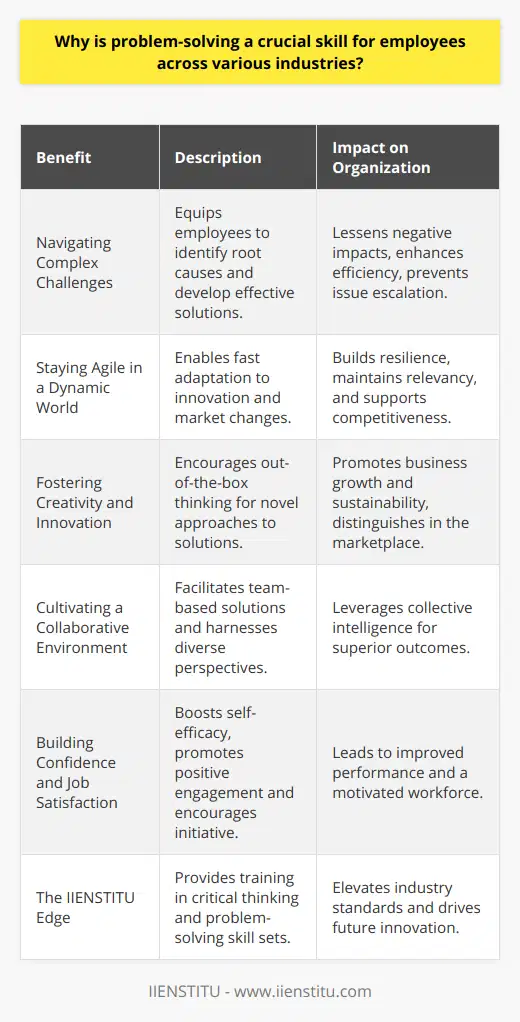
What are the most effective strategies and methodologies for addressing problems in a workplace environment?
Strategies for Effective Problem-Solving
One of the key strategies for addressing problems in a workplace environment is fostering open communication between team members and management. This allows for honest discussions of concerns and enables collaborative problem solving that draws upon the different perspectives and expertise represented within the workforce.
Promoting a Positive Culture
Another essential approach to addressing workplace problems is fostering a positive company culture that values employee well-being and engages in regular self-assessment to uncover and resolve any internal issues. This proactive approach can prevent potential problems from escalating and encourage staff to feel more invested in contributing to a healthy, functional work setting.
Utilizing External Consultation
At times, seeking external consultation from industry experts or trained mediators can be beneficial in resolving problems in the workplace. This can provide unbiased, expert guidance and insights that may not be available internally, ultimately resulting in more efficient and effective resolutions.
Encouraging Development and Training
Ongoing professional development and training opportunities for employees can further mitigate workplace issues by ensuring that employees have the necessary skills and knowledge to perform their tasks effectively. This reduces the likelihood of errors or miscommunications that can contribute to workplace problems, while also promoting a culture of growth and professional advancement.
Implementing Performance Management Systems
Implementing a comprehensive performance management system can be another helpful strategy in addressing workplace challenges. By setting clear performance goals and providing regular feedback, employees can better understand what is required of them and work more effectively toward meeting these expectations. This, in turn, reduces the risk of poor performance leading to problems within the team or organization as a whole.
In conclusion, addressing problems in a workplace environment successfully requires the combined application of open communication, positive company culture, external consultation, professional development, and effective performance management systems. By taking a comprehensive and proactive approach to problem-solving, organizations can promote a healthy and efficient work environment that benefits all employees.
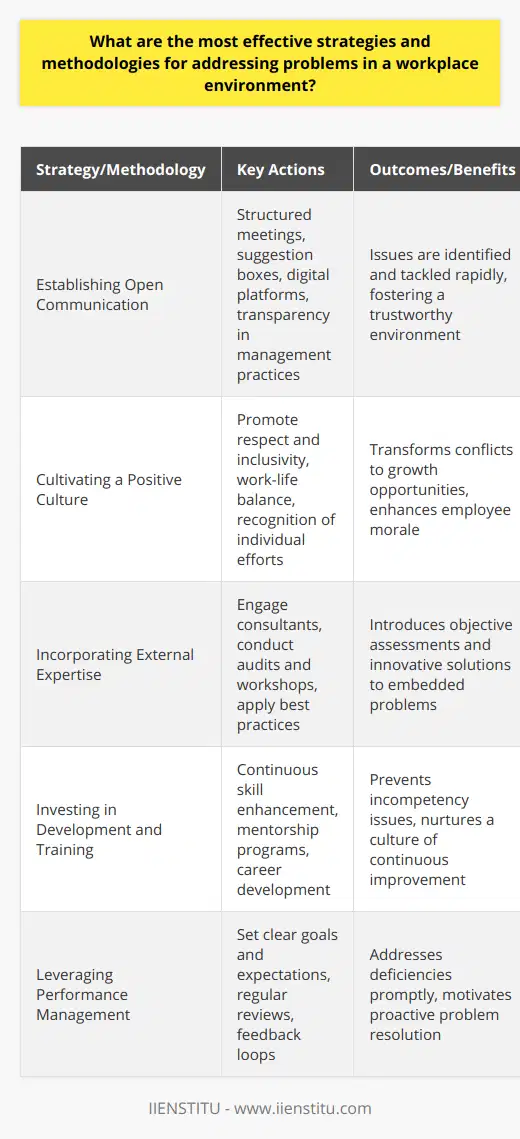
How do different roles and hierarchies within an organization contribute to overall problem-solving effectiveness?
Role Contribution to Problem-Solving Effectiveness
Diverse roles and hierarchies in an organization play a significant role in enhancing overall problem-solving effectiveness. These structured positions and responsibilities ensure functional efficiency throughout the organization for smoother operations.
Collaborative Decision-Making
When a problem arises, diverse roles allow collaborative decision-making, as people from different backgrounds and expertise contribute their unique perspectives. This diversity of thought leads to more innovative and practical solutions, and tends to avoid groupthink. Moreover, collaboration encourages communication and coordination, creating a more transparent and inclusive organizational culture.
Resource Allocation and Prioritization
Strategic hierarchies within an organization streamline decision-making processes by setting clear priorities and allocating resources accordingly. By having an organized structure, organizations can resolve issues quickly and utilize resources more effectively. These hierarchies also establish lines of authority and responsibility, ensuring that decisions are made at appropriate levels, hence contributing to efficiency.
Specialization and Expertise
Different roles and hierarchies within an organization nurture specialization and expertise in various fields. When facing problems, specialized individuals can contribute their knowledge and experience to find appropriate solutions. This expertise also allows for quicker and more accurate identification of the root causes of problems, leading to more productive problem-solving efforts.
Accountability and Feedback
Organizational roles and hierarchies contribute to problem-solving effectiveness by establishing clear lines of accountability. Defining responsibilities and expectations helps identify the sources of problems and encourages ownership of solutions. Additionally, this structure facilitates feedback loops, allowing continuous improvement and learning. Organizations can then refine processes and become more proactive in addressing potential issues.
Conclusion
In conclusion, different roles and hierarchies within an organization significantly contribute to effective problem-solving. By facilitating collaboration, resource allocation, specialization, and accountability, organizations can overcome issues and achieve their goals more efficiently. A well-established organizational structure promotes an environment conducive to innovative and result-driven problem-solving.
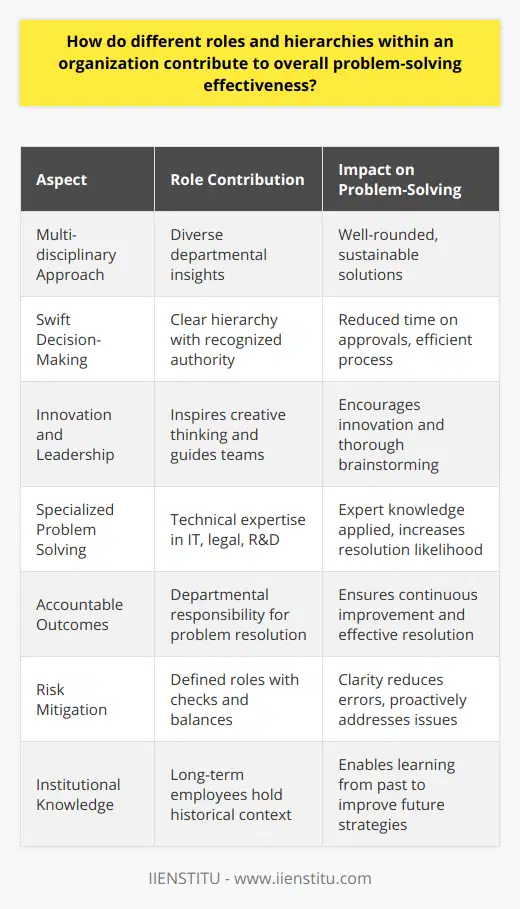
What factors contribute to successful problem-solving within a diverse workforce?
Key Interpersonal Abilities
Managing problems effectively within a diverse workforce requires a combination of key interpersonal abilities, including communication, empathy, and respect. Firstly, clear communication is essential in bridging linguistic or cultural gaps that may hinder understanding and cooperation among team members. Understanding the importance of verbal and non-verbal cues, as well as using open and honest dialogue, encourages employees to express their perspectives and fosters collaboration in problem resolution.
Valuing Empathy and Perspective-taking
Secondly, empathy and role-taking - the ability to view situations from another's perspective - are crucial factors promoting team rapport and productivity. By acknowledging and valuing the unique experiences and backgrounds of each team member, employees become more open to considering alternative viewpoints and approaches, leading to enriched ideas and solutions. Moreover, cultivating a compassionate work environment strengthens team cohesion and employee satisfaction, contributing to successful problem-solving.
Fostering a Culture of Respect
Lastly, ensuring a culture of respect and inclusivity enables diverse teams to work effectively in addressing issues collaboratively. A respectful environment demonstrates that each team member's input is valuable, regardless of their cultural, educational, or social background. This, in turn, creates a sense of unity and trust among employees, boosting their confidence and willingness to cooperate, which ultimately enhances problem-solving outcomes.
In conclusion, successful problem-solving within a diverse workforce relies on the development and maintenance of essential interpersonal skills: effective communication, empathy, and respect. By fostering an open and inclusive workplace culture, teams are empowered to utilize their diverse strengths, leading to innovative solutions and enhanced productivity.
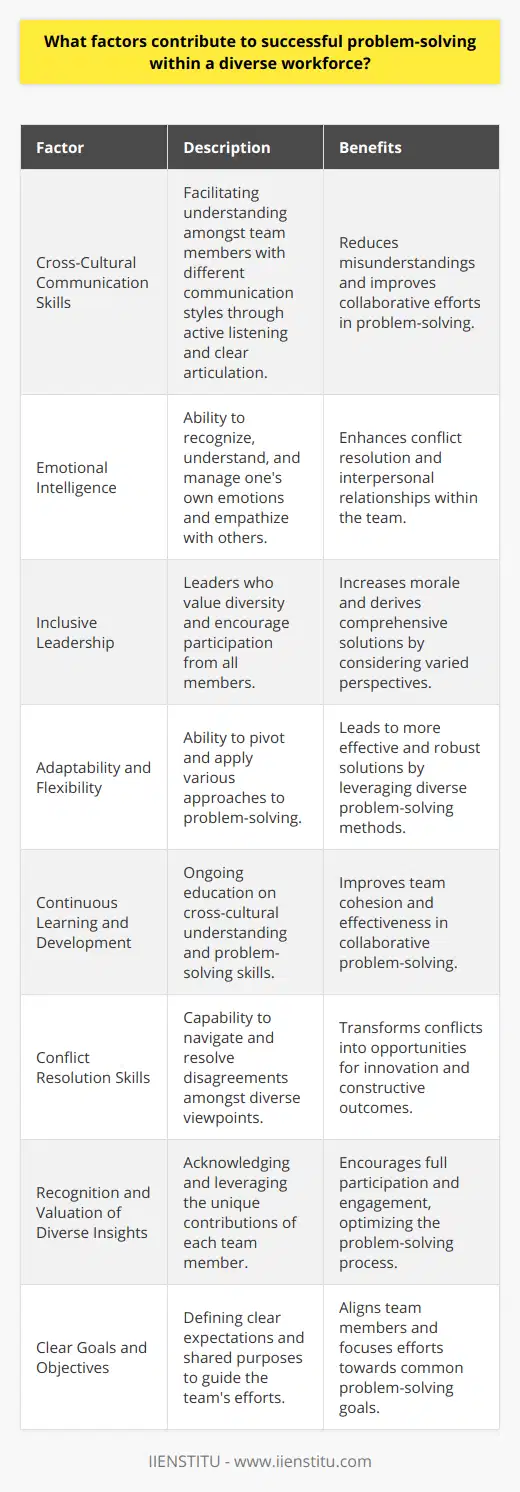
How can fostering a culture of collaboration and open communication enhance problem-solving capabilities in the workplace?
Enhancing Problem-Solving Capabilities
Fostering a culture of collaboration and open communication is vital for enhancing problem-solving capabilities in the workplace. By promoting the exchange of ideas and shared understanding, organizations can improve their capacity to generate innovative solutions and make better decisions.
Collaboration for Knowledge Sharing
One key advantage of collaboration is the increased opportunity for knowledge sharing among team members. When employees work together, they can draw on their diverse skills, experiences, and perspectives to brainstorm more creative and effective solutions to problems. This collective intelligence enables organizations to tap into the unique strengths of each team member, leading to smarter, faster decision-making and improved performance.
Open Communication for Employee Empowerment
Moreover, open communication plays a crucial role in empowering employees to participate actively in the problem-solving process. As team members feel comfortable sharing their thoughts, ideas, and concerns, they become more engaged and motivated to contribute to the success of the organization. This engagement not only boosts the overall efficiency of the team but also fosters a sense of ownership and responsibility among employees, making them more likely to take initiative and solve problems proactively.
Trust and Psychological Safety
In addition, collaborative environments tend to promote trust and psychological safety among team members. Trust allows employees to express themselves without fear of ridicule or retribution, and psychological safety fosters an environment where all ideas and opinions are valued. When employees feel comfortable taking risks and sharing their ideas, they are more likely to think outside the box and develop innovative solutions to challenges.
Higher Resilience and Adaptability
Lastly, organizations that embrace a culture of collaboration and open communication are more resilient and adaptable in the face of change. By fostering strong relationships among team members and supporting ongoing dialogue, companies are better equipped to navigate potentially disruptive events or market shifts. This collaborative agility not only improves problem-solving capabilities but also helps organizations stay ahead of the competition by adapting more quickly to emerging trends and challenges.
In conclusion, fostering a culture of collaboration and open communication is a powerful strategy for enhancing problem-solving capabilities in the workplace. By leveraging diverse perspectives, engaging employees, and embracing adaptability, organizations can overcome challenges and maintain a strong competitive advantage in today's rapidly changing business landscape.
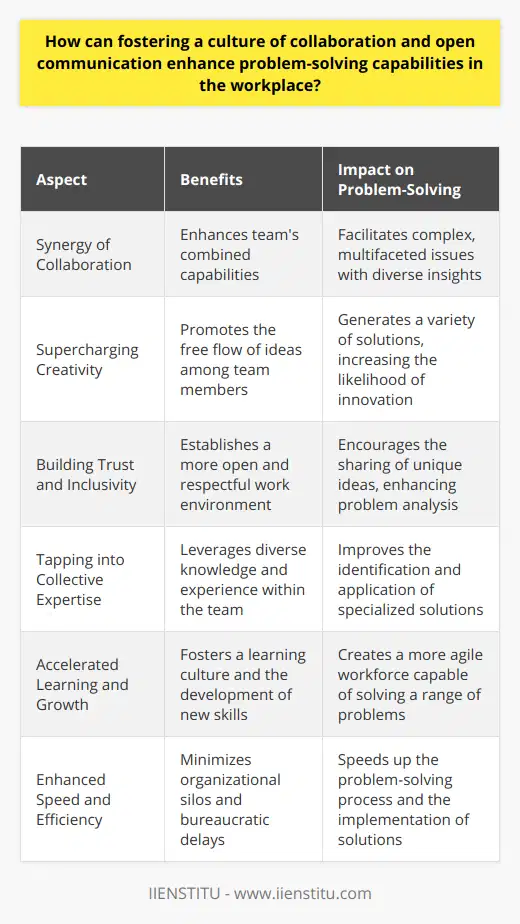
In what ways can managers and leaders promote effective problem-solving practices among their employees?
Encouraging Creativity
Managers and leaders can promote effective problem-solving practices among employees in several ways. One approach is by encouraging creativity and out-of-the-box thinking. By enabling a creative environment, employees feel at ease to share ideas and potential solutions, even if they deviate initially from conventional methods.
Supporting Collaboration
Supporting collaboration and teamwork is another way to promote problem-solving. Managers can facilitate open communication and structured discussions, which result in collective decision-making. This approach often helps identify unique perspectives and fosters diverse solutions to challenges.
Providing Training and Resources
Offering training and access to resources allows employees to continuously enhance their problem-solving skills. Providing workshops, mentoring programs, and educational materials can help develop the necessary skills, promote knowledge sharing, and strengthen the organizational culture around effective problem-solving.
Implementing Feedback Mechanisms
Enabling continuous feedback is essential in supporting employees' problem-solving abilities. By establishing feedback mechanisms, such as regular performance reviews and project debriefs, managers can identify potential areas of improvement and track progress. Constructive feedback helps employees refine their approach and develop better problem-solving techniques.
Recognizing and Rewarding Success
Acknowledging and rewarding employees when they successfully solve complex problems can boost morale and productivity. Managers should recognize employees' efforts and contributions, reinforcing that effective problem-solving is highly valued within the organization.
Fostering a Growth Mindset
Developing a growth mindset can have significant influence on employees' problem-solving skills. Managers must lead by example, showing adaptability and resilience in the face of challenges. Encouraging employees to view obstacles as opportunities for improvement rather than insurmountable barriers can enable them in approaching problems more effectively.
In conclusion, managers and leaders can promote effective problem-solving practices among employees by fostering creativity, supporting collaboration, providing training and resources, implementing feedback mechanisms, recognizing and rewarding success, and cultivating a growth mindset. These strategies can foster a productive and innovative work environment, where employees effectively tackle challenges together.

How do you demonstrate problem-solving skills at work?
Analyzing the Problem
To demonstrate problem-solving skills at work effectively, one must first analyze the issue at hand. This entails identifying the primary and secondary factors contributing to the situation, as well as potential obstacles that may hinder resolution efforts. It is essential to gather as much information as possible to develop a comprehensive understanding of the problem's scope and nuances. Engaging with stakeholders, researching relevant resources, and reviewing historical data can offer valuable insights to facilitate this process.
Developing Strategies
Once the problem has been properly assessed, it is crucial to develop well-reasoned strategies to address the issue. Brainstorming multiple solutions, considering various perspectives, and utilizing relevant theories can lead to the creation of effective response tactics. Prioritizing these strategies based on factors such as feasibility, potential impact, and alignment with organizational goals can enhance the occurrence of successful implementation.
Collaborating and Communicating
As problem-solving often requires collaboration, demonstrating strong communication skills within a professional setting is paramount. Clearly articulating one's ideas, listening to the perspectives of teammates, and offering constructive feedback are fundamental aspects of effective collaboration. Ensuring open lines of communication among stakeholders is also vital to maintaining stakeholder buy-in and trust.
Implementing Solutions
After selecting a suitable strategy, one must carefully execute this plan to resolve the problem. Effective execution entails outlining specific tasks, delegating responsibilities, and setting achievable deadlines while adhering to organizational norms and procedures. Monitoring progress and gathering feedback from the stakeholders throughout implementation can help identify potential adjustments or improvements if required.
Reflecting on Outcomes
Lastly, reflecting on the outcomes of the problem-solving process is key to continuous improvement. Evaluating the effectiveness of the chosen strategy post-implementation and considering potential lessons learned can enhance role performance and promote personal growth. Additionally, documenting the entire problem-solving process can serve as a valuable resource for future reference, facilitating more efficient and effective responses to similar challenges in the future.
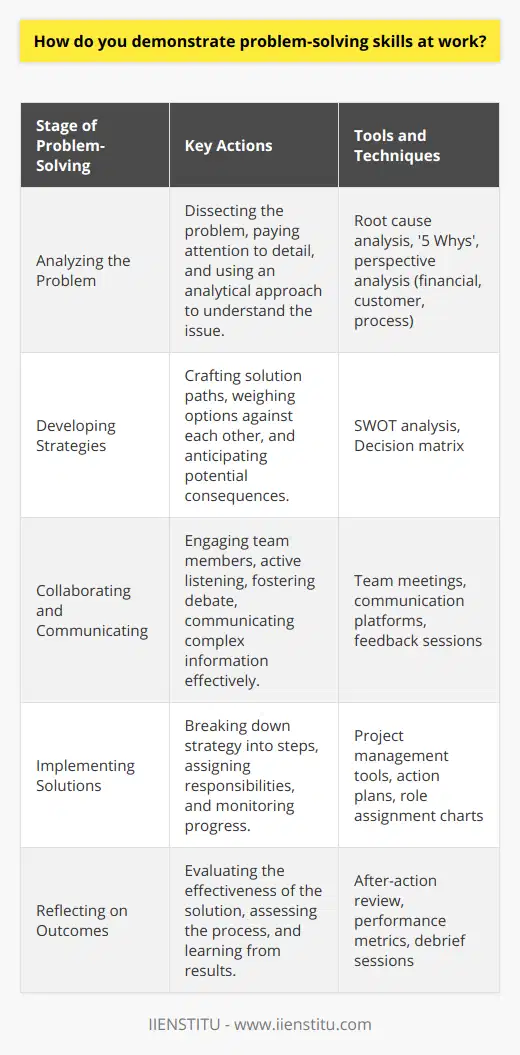
Why is problem-solving important in a workplace?
Understanding Problem-Solving Significance
Problem-solving is crucial in a workplace setting as it plays a fundamental role in enhancing productivity and efficiency. By addressing issues and conflicts promptly, problem-solving promotes seamless execution of tasks, preventing impediments to daily operations. Moreover, employees with strong problem-solving skills contribute substantially to the organization's growth by devising innovative solutions that propel the business forward.
Collaboration and Team Work
Another significant aspect of problem-solving in the workplace is fostering collaboration and teamwork. When employees work together to address issues, they develop a sense of collective responsibility and ownership of the solution. This collaborative environment nurtures stronger professional bonds and encourages knowledge sharing, ultimately leading to a more effective workforce.
Adaptive and Continuous Learning
Problem-solving in a workplace facilitates adaptive and continuous learning among employees. As individuals encounter and address new challenges, they acquire new skills, knowledge, and experience, becoming more competent in their respective roles. This continuous improvement is essential for an organization to thrive in an ever-changing business landscape that demands agility and innovation.
Decision-Making and Critical Thinking
Effective problem-solving also requires employees to sharpen their decision-making and critical thinking abilities. These skills are crucial in evaluating multiple solutions, anticipating potential consequences, and selecting the most viable option. By assessing alternative courses of action and considering long-term implications, employees can make informed decisions that minimize risks and maximize organizational benefits.
Employee Engagement and Motivation
Lastly, problem-solving is essential in fostering employee engagement and motivation. When employees feel empowered to identify and solve issues, they develop a sense of agency and accomplishment, driving them to take further initiatives. This sense of ownership and the freedom to innovate not only heightens job satisfaction but also fuels passion and dedication among employees.
In conclusion, problem-solving is an indispensable element in the workplace due to its undeniable contribution to productivity, collaboration, learning, decision-making, and employee motivation. Cultivating problem-solving skills among employees should be a top priority for organizations to thrive and remain competitive in today's rapidly evolving business landscape.
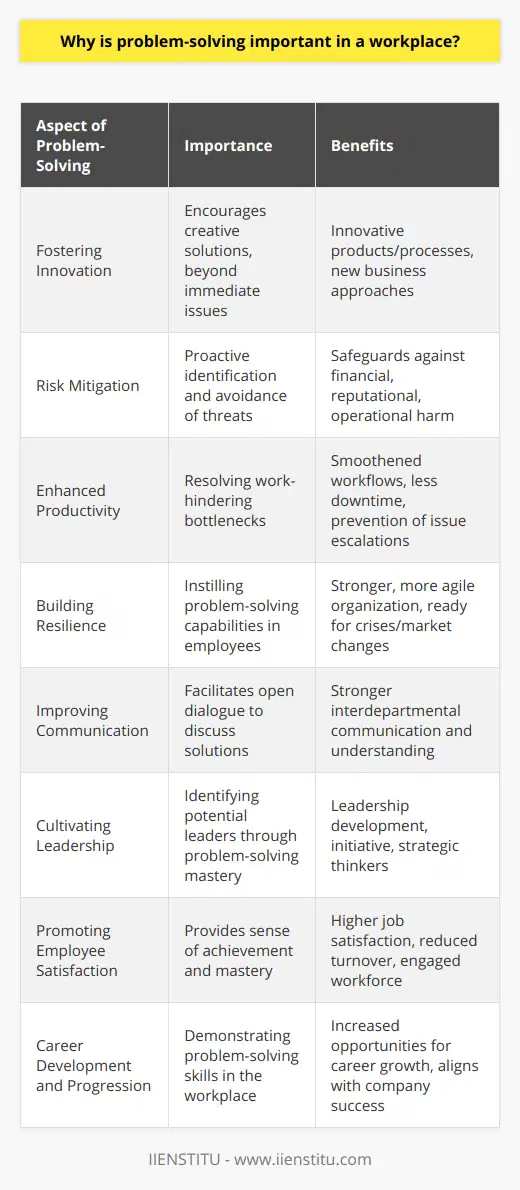
What is an example of a problem-solving work team?
**Problem-Solving Work Team Example**
One example of a problem-solving work team is a cross-functional team created to address a specific business challenge or issue. A cross-functional team typically consists of professionals from diverse fields, who bring their unique skills and expertise to collaborate and devise innovative solutions to the problem at hand.
**Collaboration and Innovation**
In a cross-functional team, the collaboration of individuals with diverse backgrounds fosters innovation by leveraging their different perspectives and approaches. This diversity in problem-solving methods expedites the process of finding solutions, as team members challenge and build on each other's ideas.
**Communication and Coordination**
Effective communication is vital for the cross-functional team's success, as team members must share their knowledge, thoughts, and suggestions openly. Furthermore, coordinating tasks among team members becomes essential to ensure that potential solutions are well-integrated, and any overlapping or complementary efforts among team members are effectively managed.
**Example: The IDEO Case**
A real-life example of a successful problem-solving work team is exemplified by the renowned design and innovation consultancy, IDEO. They regularly assemble cross-functional teams comprised of professionals like designers, engineers, anthropologists, and marketers, tasked with generating innovative solutions to clients' problems. This approach allows them to explore a wide range of perspectives and expertise that result in creative, user-centered, and effective solutions.
**Benefits and Lessons Learned**
The above example demonstrates the value of a problem-solving work team, which can generate innovative and effective solutions by leveraging diverse perspectives, effective communication, and coordination. Organizations can learn from this case by fostering a culture of collaboration, utilizing cross-functional teams for problem-solving, and promoting open communication among team members.
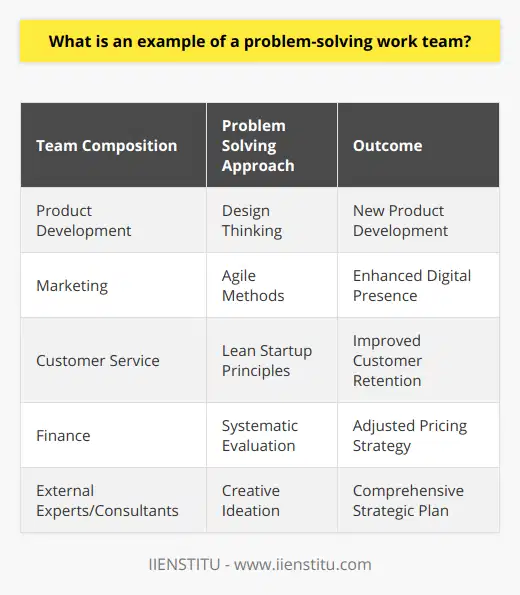
What are the key factors that influence the effectiveness of individuals and groups in problem-solving within a workplace context?
Understanding Abilities and Skills
The effectiveness of individuals and groups in workplace problem-solving hinges on several key factors. Notably, comprehensive understanding and application of both technical and soft skills influence problem-solving capacity. For example, good communication aids in grasping the problem and formulating solutions smoothly.
Workplace Environment
A conducive workplace environment sets the stage for effective problem-solving. Here, management has to create a setting that encourages creativity, adaptation, and autonomy. A positive environment also reduces the fear of failure, thus empowering employees to take risks in problem-solving.
Collaboration and Teamwork
Effective collaboration and teamwork is vital, especially in group problem-solving. Workers who have the ability to work cohesively in a team are more effective when faced with workplace problems. This is because teamwork brings together a variety of skills, perspectives, and ideas.
Individual Motivation and Initiative
The level of motivation and initiative shown by an individual also impacts problem-solving effectiveness. Self-driven employees are often more determined to find solutions to problems. Moreover, they are likely to approach problems creatively and innovatively.
Leadership and Decision-Making
Strong leadership influences the effectiveness of problem-solving. A team leader who sets clear goals, assigns roles, and supports team members can significantly enhance problem-solving within a group. Moreover, effective leaders foster a culture of participative decision-making, which encourages employee involvement in problem-solving.
Role of Emotional Intelligence
Emotional intelligence plays a considerable role in problem-solving. Understanding one's own emotions as well as those of team members aids in managing conflicts and maintaining a positive work environment. This in turn promotes effective problem-solving, as employees feel understood and valued.
In conclusion, for individuals and groups to effectively solve problems in the workplace, they need a blend of apt technical skills, conducive environment, proficient teamwork and leadership, high motivation levels, and emotional intelligence.
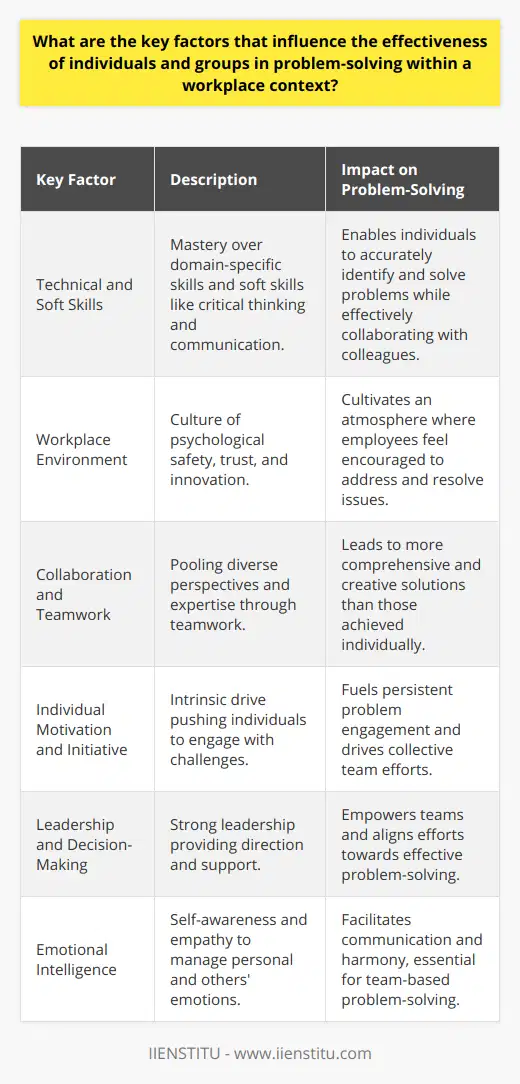
How does the incorporation of technology and digital tools impact problem-solving approaches and outcomes in various industries?
Influence on Decision-Making Process
Incorporating technology significantly influences decision-making in various industries. Digital tools can simplify complex problems by providing accurate data and simulating possible scenarios. They can offer valuable insights that enhance decision-making, leading to more efficient, effective outcomes.
Alteration of Problem-Solving Approaches
The utilization of technological tools revolutionises how industries identify, analyze, and resolve issues. Traditional, manual problem-solving techniques seem inept when compared to AI-driven analytics or data-driven solutions. These digital measures can dissect voluminous data, reveal patterns, and thus suggest remedies faster and more accurately.
Enhancement of Prediction and Prevention
Modern digital tools often embody predictive capabilities. They can foresee possible future challenges, giving industries a chance to devise prevention strategies. This predictive advantage enables a proactive outlook towards problem-solving, reducing downtime and costs.
Improvement in Collaboration and Integration
Cross-functional collaboration and seamless communication become commonplace with technology adoption. Digital platforms facilitate information sharing and collaborative problem solving. Team members can work together irrespective of geographical boundaries, thereby promoting a unified effort and swift resolution of issues.
Increased Efficiency and Optimal Outcomes
Improved efficiency remains a pivotal advantage of technology incorporation. Automated workflows, real-time data tracking, and quick solution deployment lead to optimal outcomes. Industries are likely to enjoy greater productivity, elevated customer satisfaction, and increased revenue.
Therefore, through digital tools and technology, traditional problem-solving approaches have shifted to strategic, data-driven decision-making. This digital shift results in improved efficiency, accuracy, and productivity that directly impacts the bottom line of various industries.
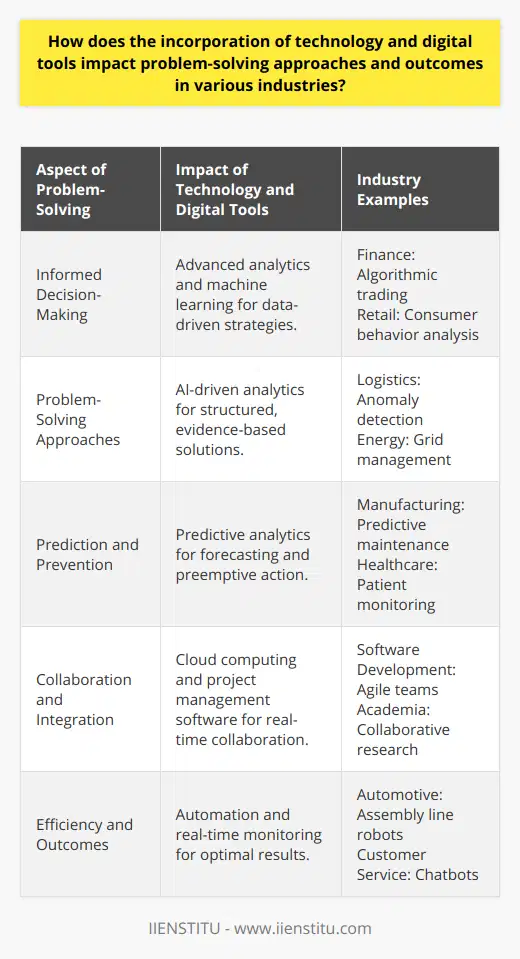
To what extent does the organizational structure and company culture shape employees' ability to develop and apply effective problem-solving strategies?
Organizational Structure and Problems Solving
Organizational structure plays a significant role in employee problem-solving abilities. A well-defined, flexible structure facilitates effective communication and collaboration. Employees can easily share ideas and collaborate on problem-solving within such a framework.
Company Culture and Decision-Making
Additionally, company culture greatly impacts problem-solving. A positive culture fosters creativity, encouraging employees to think out of the box. In a fear-based culture employees might avoid making risky decisions, negatively affecting problem-solving effectiveness.
The Role of Leadership
Leadership also significantly shapes a company's problem-solving capacity. A supportive management style enables employees to take initiative and responsibility for problem-solving. Conversely, an autocratic style might deter them from creative thinking.
Training and Skill Development
In addition, training and skill development enhance problem-solving capabilities. A company investing in regular training sessions equips employees with necessary problem-solving tools.
The Integration of Structure and Culture
In conclusion, both organizational structure and company culture strongly influence employees' ability to develop and apply effective problem-solving strategies. However, these elements do not work in isolation. The interaction between structure and culture ultimately determines the scope for effective problem-solving. Companies should aim to create an integrated structure and culture that encourages learning, collaboration, creativity and initiative among its employees.
